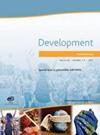Myonuclear position and blood vessel organization during skeletal muscle postnatal development.
IF 3.7
2区 生物学
Q1 DEVELOPMENTAL BIOLOGY
引用次数: 0
Abstract
Skeletal muscle development is a complex process involving myoblast fusion to generate multinucleated fibers. Myonuclei first align in the center of the myotubes before migrating to the periphery of the myofiber. Blood vessels (BVs) are important contributors to the correct development of skeletal muscle, and myonuclei are found next to BVs in adult muscle. Here, we show that most myonuclear migration to the periphery occurs between E17.5 and P1. Furthermore, myonuclear accretion after P7 does not result in centrally nucleated myofibers as observed in the embryo. Instead, myonuclei remain at the periphery of the myofiber without moving to the center. Finally, we show that hypovascularization of skeletal muscle alters the interaction between myonuclei and BVs, suggesting that BVs may contribute to myonuclear positioning during skeletal muscle postnatal development. Overall, this work provides a comprehensive analysis of skeletal muscle development during the highly dynamic postnatal period, bringing new insights about myonuclear positioning and its interaction with BVs.骨骼肌产后发育过程中的肌核位置和血管组织
骨骼肌的发育是一个复杂的过程,涉及肌母细胞融合生成多核纤维。肌核首先在肌管中心排列,然后迁移到肌纤维外围。血管(BV)是骨骼肌正确发育的重要因素,而成肌中的肌核就在血管旁边。在这里,我们发现大部分肌核向外周的迁移发生在E17.5至P1期间。此外,P7 后的肌核增生并不像在胚胎中观察到的那样导致肌纤维向中心成核。相反,肌核停留在肌纤维外围,没有向中心移动。最后,我们发现骨骼肌的低血管化改变了肌核与 BV 之间的相互作用,这表明 BV 可能有助于骨骼肌产后发育过程中的肌核定位。总之,这项工作全面分析了骨骼肌在出生后高度动态时期的发育,为肌核定位及其与 BV 的相互作用带来了新的见解。
本文章由计算机程序翻译,如有差异,请以英文原文为准。
求助全文
约1分钟内获得全文
求助全文
来源期刊

Development
生物-发育生物学
CiteScore
6.70
自引率
4.30%
发文量
433
审稿时长
3 months
期刊介绍:
Development’s scope covers all aspects of plant and animal development, including stem cell biology and regeneration. The single most important criterion for acceptance in Development is scientific excellence. Research papers (articles and reports) should therefore pose and test a significant hypothesis or address a significant question, and should provide novel perspectives that advance our understanding of development. We also encourage submission of papers that use computational methods or mathematical models to obtain significant new insights into developmental biology topics. Manuscripts that are descriptive in nature will be considered only when they lay important groundwork for a field and/or provide novel resources for understanding developmental processes of broad interest to the community.
Development includes a Techniques and Resources section for the publication of new methods, datasets, and other types of resources. Papers describing new techniques should include a proof-of-principle demonstration that the technique is valuable to the developmental biology community; they need not include in-depth follow-up analysis. The technique must be described in sufficient detail to be easily replicated by other investigators. Development will also consider protocol-type papers of exceptional interest to the community. We welcome submission of Resource papers, for example those reporting new databases, systems-level datasets, or genetic resources of major value to the developmental biology community. For all papers, the data or resource described must be made available to the community with minimal restrictions upon publication.
To aid navigability, Development has dedicated sections of the journal to stem cells & regeneration and to human development. The criteria for acceptance into these sections is identical to those outlined above. Authors and editors are encouraged to nominate appropriate manuscripts for inclusion in one of these sections.
 求助内容:
求助内容: 应助结果提醒方式:
应助结果提醒方式:


